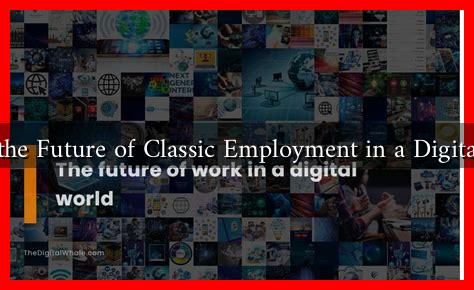-
Table of Contents
What Is the Future of Classic Employment in a Digital World?
As we navigate through the 21st century, the landscape of employment is undergoing a seismic shift. The rise of digital technology has transformed how we work, communicate, and even think about employment itself. Classic employment, characterized by traditional 9-to-5 jobs, is being challenged by new models that prioritize flexibility, remote work, and gig opportunities. This article explores the future of classic employment in a digital world, examining the implications for workers, employers, and the economy at large.
The Shift Towards Remote Work
One of the most significant changes in the employment landscape is the widespread adoption of remote work. The COVID-19 pandemic accelerated this trend, forcing companies to adapt quickly to a digital-first approach. According to a report by McKinsey, 20-25% of the workforce in advanced economies could work remotely three to five days a week without losing productivity.
- Flexibility: Remote work offers employees greater flexibility in managing their time and work-life balance.
- Cost Savings: Companies can save on overhead costs associated with maintaining physical office spaces.
- Access to Global Talent: Employers can tap into a broader talent pool, unrestricted by geographical boundaries.
However, this shift also presents challenges. Companies must invest in technology and training to ensure that remote teams remain productive and engaged. Additionally, the lack of in-person interaction can lead to feelings of isolation among employees, necessitating new strategies for team building and communication.
The Rise of the Gig Economy
The gig economy is another facet of the changing employment landscape. Freelancing, contract work, and short-term projects are becoming increasingly popular, driven by platforms like Upwork, Fiverr, and TaskRabbit. According to a report by Intuit, by 2023, 43% of the U.S. workforce is expected to be part of the gig economy.
- Autonomy: Gig workers enjoy the freedom to choose their projects and set their schedules.
- Diverse Opportunities: The gig economy allows individuals to explore various fields and develop new skills.
- Income Variability: While gig work can be lucrative, it often lacks the stability and benefits associated with traditional employment.
As more individuals opt for gig work, traditional employers may need to adapt their hiring practices and benefits structures to attract and retain talent. This could include offering more flexible work arrangements or creating hybrid roles that combine elements of traditional employment with gig opportunities.
Technological Advancements and Automation
Technological advancements, particularly in artificial intelligence (AI) and automation, are reshaping the future of work. While these technologies can enhance productivity and efficiency, they also pose a threat to classic employment. A report by the World Economic Forum predicts that by 2025, 85 million jobs may be displaced by automation, while 97 million new roles could emerge that are more suited to the new division of labor between humans and machines.
- Job Transformation: Many roles will evolve rather than disappear, requiring workers to adapt and upskill.
- New Job Creation: Emerging fields such as AI ethics, data analysis, and cybersecurity will create new employment opportunities.
- Reskilling and Upskilling: Workers will need to engage in continuous learning to remain competitive in the job market.
Conclusion: Embracing Change in the Employment Landscape
The future of classic employment in a digital world is not about the demise of traditional jobs but rather their evolution. As remote work, gig opportunities, and technological advancements reshape the employment landscape, both workers and employers must adapt to thrive in this new environment. Embracing flexibility, investing in skills development, and fostering a culture of continuous learning will be essential for success.
In summary, the future of work is characterized by:
- Increased remote work and flexibility.
- The rise of the gig economy and diverse employment opportunities.
- Technological advancements that require adaptation and reskilling.
As we move forward, it is crucial for individuals and organizations to remain agile and open to change, ensuring that they are well-prepared for the future of work. For more insights on the evolving job market, you can visit World Economic Forum.


